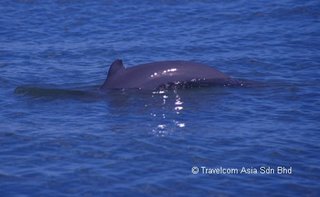Whilst populations of Irrawaddy dolphins are declining in a number of countries, the dolphin is considered locally common in some places. There is evidence that Sarawak is one such place. The Irrawaddy is the most commonly sighted dolphin in Sarawak waters. Furthermore, its distribution is not limited to a single river system.
Known locally as “pesut” or “empesut”, the Irrawaddy dolphin is found along the length of Sarawak’s coast from Tanjung Datu to Miri, and is often sighted in all of Sarawak’s major river estuaries including Sematan, Santubong, Bako, Muara Tebas, Kabong, Batang Rajang and Batang Igan. It is also enters major river systems including the Sadong, Kabong, Saribas, Rajang, Igan, Bintulu, Miri and Limbang Rivers.
During the dry season from March-November Irrawaddy dolphins are frequently sighted in two areas near Kuching - the Bako-Buntal Bay and the Santubong estuary. Dolphins have been spotted in these areas during the wet season but owing to rising swells and rain, sightings are less frequent.
At Santubong, Irrawaddys are often seen in the mouth of the Santubong River, at the nearby Kuala Sibu Laut and in the Salak River. On rare occasions they are sighted off Damai Beach and are sometimes sighted near the Damai Golf Course. Whilst it is common to spot one or two groups of dolphins in the Santubong area, on occasions four or five groups, together comprising up to 30 dolphins, have been sighted close together in the Santubong estuary.
In Santubong, Salak and Sibu Laut Irrawaddy dolphins are often seen following trawlers and swimming near small fishing craft. Local fishermen can also be seen throwing fish to dolphins after they haul in their nets. After the fishermen haul in their nets they sort out the fish that they can not sell in the market and throw this ‘trash’ fish back into the sea. The Irrawaddy dolphins have learnt that a free meal can be had and wait around the boats.
Known locally as “pesut” or “empesut”, the Irrawaddy dolphin is found along the length of Sarawak’s coast from Tanjung Datu to Miri, and is often sighted in all of Sarawak’s major river estuaries including Sematan, Santubong, Bako, Muara Tebas, Kabong, Batang Rajang and Batang Igan. It is also enters major river systems including the Sadong, Kabong, Saribas, Rajang, Igan, Bintulu, Miri and Limbang Rivers.
During the dry season from March-November Irrawaddy dolphins are frequently sighted in two areas near Kuching - the Bako-Buntal Bay and the Santubong estuary. Dolphins have been spotted in these areas during the wet season but owing to rising swells and rain, sightings are less frequent.
At Santubong, Irrawaddys are often seen in the mouth of the Santubong River, at the nearby Kuala Sibu Laut and in the Salak River. On rare occasions they are sighted off Damai Beach and are sometimes sighted near the Damai Golf Course. Whilst it is common to spot one or two groups of dolphins in the Santubong area, on occasions four or five groups, together comprising up to 30 dolphins, have been sighted close together in the Santubong estuary.
In Santubong, Salak and Sibu Laut Irrawaddy dolphins are often seen following trawlers and swimming near small fishing craft. Local fishermen can also be seen throwing fish to dolphins after they haul in their nets. After the fishermen haul in their nets they sort out the fish that they can not sell in the market and throw this ‘trash’ fish back into the sea. The Irrawaddy dolphins have learnt that a free meal can be had and wait around the boats.

